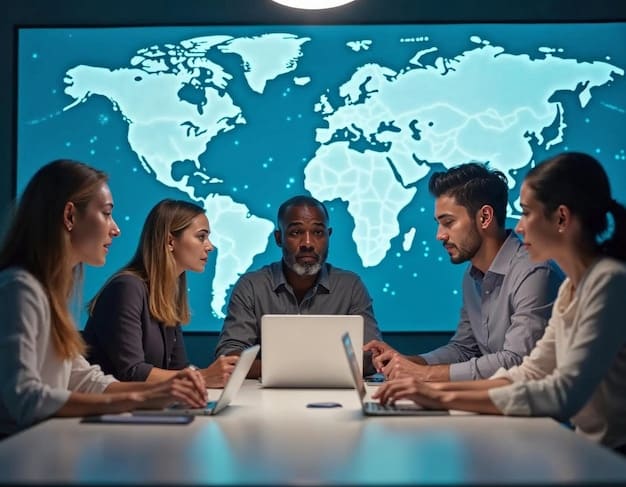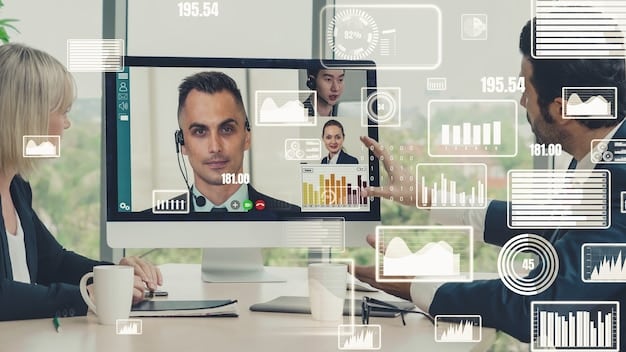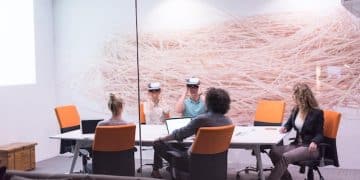Remote Collaboration Mastery: 7 Strategies for Effective Teamwork in a Distributed World

Mastering remote collaboration involves implementing strategic approaches like asynchronous communication, robust digital tools, and fostering a culture of trust to overcome geographical barriers and enhance team productivity in distributed work environments.
In an increasingly interconnected yet geographically dispersed world, the ability to effectively collaborate remotely has become not just a convenience, but a critical competence for any forward-thinking organization. This article explores Remote Collaboration Mastery: 7 Strategies for Effective Teamwork in a Distributed World, offering insights grounded in practical application and expert analysis.
Embracing the Remote Work Paradigm: A Foundation for Success
The shift to remote work, accelerated by global events, has profoundly reshaped the landscape of professional collaboration. This paradigm demands a fundamental reimagining of how teams interact, share knowledge, and achieve collective goals, moving beyond mere physical proximity.
Successful remote collaboration is not simply about replicating office routines online; it’s about optimizing new communication channels, fostering autonomy, and building a resilient team culture that thrives irrespective of location. Organizations that genuinely embrace this transformation are finding avenues for increased efficiency, expanded talent pools, and enhanced employee satisfaction.
The Evolution of Workspaces
Traditionally, workspaces were defined by physical structures and designated office hours. Today, the concept of a “workspace” has expanded to encompass any location where an individual can effectively contribute, from home offices to co-working spaces to temporary mobile setups. This evolution necessitates a flexible mindset and an infrastructure that supports seamless connectivity and productivity.
Benefits Beyond the Obvious
While reduced overheads and expanded talent access are often cited, the deeper benefits of a well-implemented remote work strategy include greater employee autonomy, which can lead to higher engagement and reduced burnout. It also promotes a more results-oriented culture, shifting focus from hours spent in an office chair to measurable outcomes and contributions.
- Increased Talent Pool: Access to a global workforce, not limited by geographical constraints.
- Enhanced Flexibility: Employees can often tailor their schedules, leading to better work-life integration.
- Reduced Commuting Stress: Frees up time and energy previously spent on daily commutes.
- Cost Savings: Potential reductions in office space, utilities, and related expenses for organizations.
The successful transition to a remote-first or remote-friendly environment hinges on cultivating specific skills and adopting robust strategies. It requires a proactive approach to culture-building, clear communication protocols, and a commitment to continuous improvement. Without these foundational elements, the potential benefits can quickly turn into significant challenges.
Strategy 1: Cultivating Clear and Consistent Communication Channels
Effective communication forms the bedrock of any successful team, but its importance amplifies significantly in a remote setting. Misunderstandings can quickly escalate when visual cues are absent and spontaneous interactions are limited. Therefore, establishing clear, consistent, and intentional communication channels is paramount.
This strategy involves choosing the right tools for different types of communication – instant messaging for quick queries, video conferencing for discussions and brainstorming, and project management platforms for task assignments and progress tracking. It’s not just about the tools, however; it’s about establishing a culture where every team member understands when and how to use these channels effectively.
Asynchronous vs. Synchronous Communication
A key distinction in remote communication is between synchronous (real-time) and asynchronous (non-real-time) methods. Synchronous communication, like video calls, is crucial for building rapport, resolving complex issues, and holding brainstorming sessions. Asynchronous communication, such as emails, shared documents, or project management updates, allows team members to respond at their own pace, accommodating different time zones and workflows.
Balancing these two modes is vital. Over-reliance on synchronous communication can lead to “zoom fatigue” and disrupt focus, while neglecting it can diminish personal connection and immediacy. A thoughtful approach ensures that each communication need is met with the most appropriate and efficient method.
- Defined Expectations: Clearly outline which tools to use for different types of communication (e.g., Slack for quick questions, email for formal updates, Zoom for meetings).
- Documentation Culture: Encourage detailed documentation of discussions, decisions, and processes to minimize ambiguity and provide a single source of truth.
- Regular Check-ins: Schedule consistent synchronous check-ins (daily stand-ups, weekly team meetings) to maintain rhythm and address urgent issues.
- Active Listening: Promote active listening and clarification, especially in video calls, to ensure full comprehension.
Ultimately, a robust communication strategy for remote teams is about much more than just having the right software. It’s about instilling a discipline of clarity, promoting transparency, and fostering an environment where information flows freely and purposefully. This proactive approach minimizes confusion and builds a foundation of trust.
Strategy 2: Investing in Robust Digital Tools and Infrastructure
The backbone of any effective remote collaboration strategy lies in the digital tools and infrastructure that support it. Merely having a set of tools is insufficient; organizations must invest in a cohesive ecosystem of platforms that integrate seamlessly and provide comprehensive support for team functions. This ensures that geographical distance does not translate into operational disconnect.
Selecting the right suite of tools requires a thorough understanding of the team’s specific needs, workflows, and communication preferences. It’s about creating a digital workspace that mirrors, and in many cases, enhances the functionalities of a physical office, providing avenues for shared work, efficient communication, and streamlined project management.

Essential Tool Categories
A comprehensive remote tools ecosystem typically includes several key categories. Communication tools facilitate real-time chat and video calls. Project management tools help organize tasks, track progress, and assign responsibilities. Document collaboration platforms enable simultaneous editing and version control. Cloud storage solutions provide secure access to shared files at any time.
Ensuring that these tools are user-friendly, secure, and reliable is critical. Training team members on their effective use is just as important as the initial investment. Without proper adoption and understanding, even the most sophisticated tools can become underutilized assets.
- Communication Platforms: Slack, Microsoft Teams, Zoom for chat and video conferencing.
- Project Management Suites: Asana, Trello, Jira, Monday.com for task assignments and workflow tracking.
- Document Collaboration: Google Workspace, Microsoft 365 for real-time document editing and sharing.
- Cloud Storage & Sharing: Dropbox, Google Drive, SharePoint for secure file access.
Beyond these, specialized tools for design, coding, or data analysis may also be incorporated. The strategic integration of these tools creates a powerful digital environment that minimizes friction, reduces communication overhead, and allows remote teams to operate with the same, or even greater, efficiency as co-located ones. The key is thoughtful selection and robust implementation.
Strategy 3: Defining Clear Roles, Responsibilities, and Deliverables
In a remote environment, ambiguity can be a significant impediment to productivity and team cohesion. Without the spontaneous interactions characteristic of an office, assumptions can lead to misunderstandings and missed deadlines. Therefore, the deliberate act of defining clear roles, responsibilities, and deliverables becomes a critical strategy for remote collaboration mastery.
Teams must understand not only their individual tasks but also how their work fits into the broader objectives of the project and the organization. This clarity avoids duplication of effort, ensures accountability, and allows team members to work autonomously with confidence, knowing their contributions are aligned with collective goals.
Establishing Performance Metrics
Beyond general responsibilities, it’s crucial to establish specific, measurable, achievable, relevant, and time-bound (SMART) goals and performance metrics for remote team members. This provides a tangible framework against which progress can be assessed, and success can be celebrated. Clear metrics also help in identifying areas for improvement or additional support.
Regular review of these metrics, coupled with constructive feedback, ensures that individuals remain on track and receive the guidance they need. This process fosters a culture of ownership and results-driven activity, essential for distributed environments where direct oversight is less prevalent.
- Role Charters: Create documented role descriptions outlining primary responsibilities, key functions, and expected outcomes for each team member.
- Project Scopes: Clearly define project objectives, scope, and success criteria upfront, ensuring everyone understands the ‘why’ behind their work.
- Deliverable Checklists: For each task, specify exact deliverables, formats, and deadlines to eliminate guesswork.
- Accountability Frameworks: Implement systems (e.g., daily stand-ups, transparent dashboards) that highlight task ownership and progress.
By proactively establishing these parameters, remote teams can operate with a high degree of autonomy and efficiency. It minimizes the need for micromanagement and empowers individuals to take charge of their work, ultimately contributing to a more self-sufficient and productive collaborative unit. Clarity is the antidote to remote work challenges.
Strategy 4: Fostering a Culture of Trust and Autonomy
At the heart of successful remote collaboration lies a bedrock of trust and a commitment to fostering autonomy. In a distributed setting, it’s impossible (and undesirable) to constantly monitor team members. Therefore, an environment where trust is implicit, and individuals are empowered to manage their work, is not just beneficial but absolutely essential.
Trust in a remote context means believing that team members are dedicated, competent, and will deliver on their commitments without constant supervision. Autonomy means giving individuals the freedom to choose how and when they accomplish their tasks, as long as deliverables are met. These two elements combine to create a highly motivated and productive workforce.
Empowering Decision-Making
A key aspect of fostering autonomy is empowering team members to make decisions within their areas of responsibility. This means providing them with the necessary information, resources, and clarity on boundaries. When individuals feel trusted to make decisions, they become more invested in the outcomes and often find innovative solutions.
Leaders play a crucial role here by shifting from a command-and-control approach to one of support and enablement. They set clear expectations, provide guidance, and then step back, trusting their team to perform. This also means being comfortable with occasional mistakes, viewing them as learning opportunities rather than failures requiring intervention.
- Transparency: Share information openly about company goals, challenges, and successes to build a sense of shared purpose and trust.
- Results-Oriented Focus: Evaluate performance based on outcomes and contributions, rather than hours logged or physical presence.
- Delegation with Trust: Delegate meaningful tasks and responsibilities, giving team members ownership over their projects.
- Supportive Leadership: Leaders should act as facilitators, removing roadblocks and providing resources rather than micromanaging.
The cultivation of trust and autonomy creates a virtuous cycle: when employees feel trusted, they respond with increased responsibility and engagement. This leads to higher quality work, greater job satisfaction, and a more resilient and agile remote team, capable of navigating challenges independently.
Strategy 5: Prioritizing Regular Social Connection and Team Building
While productivity and tasks are central, the human element of teamwork often suffers in remote environments. The spontaneous water-cooler chats, shared lunches, and informal interactions that build rapport and empathy in a physical office are absent. Therefore, prioritizing regular social connection and intentional team building becomes a non-negotiable strategy for remote collaboration mastery.
These activities are not mere fripperies; they are crucial for maintaining morale, reinforcing team bonds, and preventing feelings of isolation. Strong social connections make it easier for colleagues to resolve conflicts, offer support, and celebrate successes, ultimately enhancing overall team performance and well-being.

Creating Intentional Social Spaces
Simply having the tools for video calls isn’t enough; teams need to proactively create opportunities for informal interaction. This can range from dedicated virtual social calls, where work topics are off-limits, to online games, virtual coffee breaks, or even shared playlists. The goal is to replicate, in a digital format, the casual interactions that foster camaraderie.
Some companies organize virtual “lunch and learns,” talent shows, or fitness challenges to bring team members together in non-work contexts. It’s about remembering that behind every screen is a person, and nurturing those human connections is vital for long-term remote team health.
- Virtual Water Cooler: Create a dedicated chat channel for non-work related discussions, jokes, and casual sharing.
- Social Video Calls: Schedule regular optional video calls specifically for social interaction, like virtual happy hours or themed trivia nights.
- Team-Building Activities: Organize virtual escape rooms, online games, or collaborative creative projects that encourage interaction and fun.
- Personal Check-Ins: Encourage managers to start one-on-one meetings with a non-work personal check-in to inquire about well-being.
By consciously integrating social connection and team-building activities into the remote work structure, organizations can combat the isolating effects of distance. This proactive approach strengthens interpersonal relationships, boosts team morale, and creates a sense of belonging that is crucial for sustained collaboration and overall job satisfaction.
Strategy 6: Implementing Effective Performance Management and Feedback Loops
Managing performance and providing constructive feedback can be more challenging in a remote environment where direct observation is limited. However, it is precisely in this context that robust performance management and well-structured feedback loops become even more critical. They ensure team members remain engaged, understand their impact, and continuously develop their skills.
This strategy involves moving beyond traditional annual reviews to a more continuous, empathetic, and results-focused approach. It means establishing clear expectations, providing regular, timely feedback, and creating opportunities for growth and recognition, all tailored to the nuances of a distributed team.
Continuous Feedback and Recognition
Instead of sporadic reviews, remote teams thrive on continuous feedback. This includes regular one-on-one meetings where managers provide specific, actionable feedback on performance and behavior. It also involves peer-to-peer feedback mechanisms, encouraging colleagues to openly share appreciation and constructive criticism.
Equally important is recognition. In a remote setting, where spontaneous “thank yous” might be missed, intentional recognition—public or private—helps reinforce positive behaviors and boosts morale. Celebrating milestones, achievements, and contributions, even small ones, keeps team members motivated and feeling valued.
- Regular One-on-One Meetings: Schedule frequent, dedicated check-ins to discuss progress, challenges, and developmental needs; ensure these are consistent.
- Structured Feedback Sessions: Implement formal and informal feedback mechanisms, focusing on specific behaviors and their impact rather than vague generalizations.
- Peer Recognition Programs: Encourage team members to acknowledge each other’s contributions through dedicated channels or platforms.
- Professional Development: Provide opportunities for training, skill enhancement, and career growth, demonstrating investment in their long-term success.
Effective performance management in a remote setup emphasizes accountability while fostering a supportive learning environment. It’s about building a culture where feedback is seen as a gift, continuous improvement is the norm, and every team member feels empowered to grow and contribute their best to the collective effort.
Strategy 7: Building Resilience and Adaptability for Future Challenges
The remote work landscape is constantly evolving, influenced by technological advancements, global events, and shifts in workforce demographics. Therefore, the final, overarching strategy for remote collaboration mastery is to build resilience and cultivate a continuous capacity for adaptability. This ensures that teams are not just effective today but are also prepared for the uncertainties of tomorrow.
Resilience in this context means the ability to recover quickly from difficulties, setbacks, or disruptions. Adaptability refers to the capacity to adjust to new conditions and embrace change proactively. Together, these qualities enable remote teams to remain agile and effective regardless of external circumstances.
Learning from Experience and Iteration
A key component of building resilience is the practice of continuous learning and iteration. Remote teams should regularly review their processes, tools, and communication strategies, identifying what works well and what needs improvement. This can be done through post-project retrospectives, anonymous surveys, or dedicated feedback sessions.
Embracing a mindset of experimentation, where new tools or methodologies are piloted and evaluated, allows teams to incrementally optimize their remote operations. This iterative approach minimizes risk and ensures that the team’s remote working framework remains cutting-edge and responsive to changing needs.
- Regular Audits: Periodically assess the effectiveness of current tools, processes, and communication protocols.
- Pilot Programs: Experiment with new technologies or collaborative approaches on a small scale before widespread adoption.
- Cross-Training Initiatives: Ensure that critical knowledge and skills are shared among multiple team members to minimize reliance on any single individual.
- Contingency Planning: Develop protocols for unexpected disruptions, such as internet outages, tool failures, or rapid shifts in business requirements.
By consciously investing in the resilience and adaptability of remote teams, organizations are not just preparing for the next challenge; they are building a fundamentally stronger, more agile, and future-proof workforce. This strategic foresight transforms remote work from a temporary solution into a sustainable competitive advantage.
| Key Strategy | Brief Description |
|---|---|
| 💬 Clear Communication | Establish consistent channels and practices for all communication types. |
| 🛠️ Robust Digital Tools | Invest in integrated platforms for communication, project management, and collaboration. |
| 🤝 Trust & Autonomy | Empower team members with freedom and belief in their competence. |
| 🚀 Resilience & Adaptability | Foster continuous learning and a proactive approach to change and challenges. |
Frequently Asked Questions About Remote Collaboration Mastery
The primary challenges often include communication breakdowns due to lack of non-verbal cues, feelings of isolation among team members, difficulties in maintaining a cohesive team culture, differing time zones impacting synchronous meetings, and ensuring accountability without direct oversight. These require intentional strategies to mitigate.
Maintaining a strong remote team culture involves intentional efforts such as scheduling regular non-work social interactions (virtual happy hours, game nights), fostering transparent communication from leadership, celebrating successes openly, and encouraging informal peer-to-peer discussions. Consistency in these efforts is crucial for building bonds.
Digital tools are foundational for remote collaboration, serving as virtual workspaces. They enable seamless communication (chat, video calls), project management (task tracking, workflow automation), and document sharing. The right suite of integrated tools can dramatically enhance efficiency and connectivity, bridging geographical gaps for effective teamwork.
Yes, asynchronous communication is highly effective and often preferred for remote teams, especially those across different time zones. It allows team members to respond at their convenience, reduces “meeting fatigue,” and encourages more thoughtful, detailed responses. It’s best used for non-urgent updates, documentation, and detailed discussions.
Trust is paramount in a remote team setting. Without it, managers may resort to micromanagement, stifling team autonomy and morale. When trust is established, team members feel empowered to work independently, make decisions, and take ownership, leading to higher productivity, greater job satisfaction, and a more resilient team dynamic.
Conclusion
Achieving mastery in remote collaboration is an ongoing journey, not a destination. It demands a holistic approach that integrates robust tools, clear communication, a foundation of trust, and a relentless focus on human connection. By diligently implementing these seven strategies, organizations can transform the challenges of distributed work into unparalleled opportunities for innovation, efficiency, and a truly global, engaged workforce. The future of work is undeniably remote, and those who master its nuances will lead the way.





